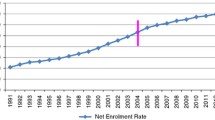Abstract
The University of the Air of Japan (UAJ) was founded with the idea of creating a university that is open to everybody in the country. In order to realize this objective, the university will expand its operation so it can provide education nationwide. However, the nationwide expansion will require many resources to be created and maintained. It is necessary to assess the effects of the education of UAJ to justify the expansion of its operation.
This study aims at quantitative evaluation of the monetary and nonmonetary effects of the education offered by UAJ. In order to find the educational effects, questionnaires were sent to the UAJ graduates, and the responses were analyzed. Monetary effects were expressed by human capital value calculated with the data on the annual earnings of the graduates. When the UAJ graduates were compared with general workers that have the same educational background as that of the UAJ graduates before the enrollment, the graduates of UAJ have more human capital value than the general workers. However, the human capital value of the UAJ graduates who had not received a college degree before the enrollment is smaller than that of the graduates of conventional universities. In respect of nonmonetary effects, the UAJ is most likely to have impacts that are different from those of conventional universities because of the varied characteristics of the UAJ students. Therefore, we set the categories of the students' expectations from the gathered data, and attempt to determine if the university is meeting the needs of the students. As a result, it was made clear that UAJ education does meet students' expectations of cultivation and convenient study conditions, but does not satisfy their expectations of occupational advancement.
Similar content being viewed by others
References
Ansari, M.M. (1992). Economics of Distance Higher Education. New Delhi: Concept Publishing.
Becker, G.S. (1975). Human Capital 2nd Edition.New York: National Bureau of Economic Research.
Daniel, J. (1995). ‘Open universities and the knowledge media: new opportunities, new threats’, Proceedings in Asian Association of Open Universities IXth annual conference, 7-18.
Hanoch, G. (1967). ‘An economic analysis of earnings and schooling’, The Journal of Human Resources 11(3), 310-329.
Iwanaga, M. (1995). ‘Open universities and the knowledge media: new opportunities, new threats’, Proceedings in Asian Association of Open Universities IXth annual conference, 391-401.
Keegan, D. and Rumble, G. (1982). ‘The DTUs: an appraisal’, in Rumble, G. and Harry, K. (eds.), The Distance Teaching Universities. London: Croom Helm, 225-249.
Levin, H.M. (1984). ‘Assessing the equalization potential of education’, Comparative Education Review 28(1), 11-27.
Ministry of Education, Science, Sports and Culture. (1996). Government Policies on Education. Tokyo: Government Publishing Office.
Muta, H. (1985). ‘The economics of the University of the Air of Japan’, Higher Education 14, 269-296.
Muta, H. and Saito, T. (1994). ‘Comprehensive cost analysis of the University of the Air of Japan’, Higher Education 28, 325-353.
Psacharopoulos, G. (1975). Earnings and Education in OECD Countries. Paris: Organization for Economic Co-operation and Development.
Rumble, G. (1986). The Planning and Management of Distance Education. London: Croom Helm.
Schultz, T.W. (1961). ‘Investment in human capital’, American Economic Review 51(1), 1-17.
Spence, M. (1973). ‘Job market signaling’, Quarterly Journal of Economics 87(3), 355-374.
Thurow, L. (1972). ‘Education and economic equality’, Public Interest 28, 66-81.
Verduin, J.R.Jr. and Clark, T.A. (1991). Distance Education. San Francisco: Jossey-Bass.
Author information
Authors and Affiliations
Rights and permissions
About this article
Cite this article
Saito, T., Muta, H. Effectiveness of the University of the Air of Japan. Higher Education 35, 163–186 (1998). https://doi.org/10.1023/A:1003031100651
Issue Date:
DOI: https://doi.org/10.1023/A:1003031100651




